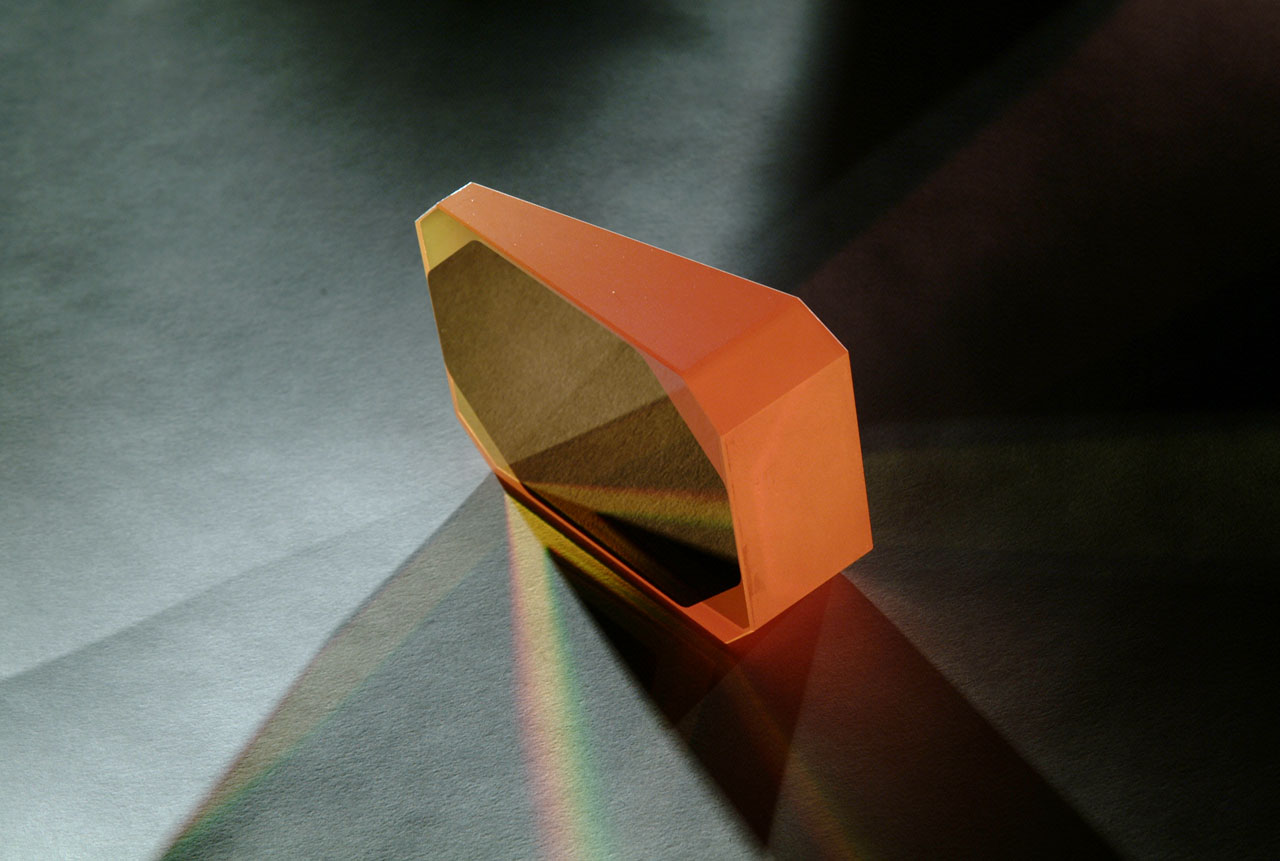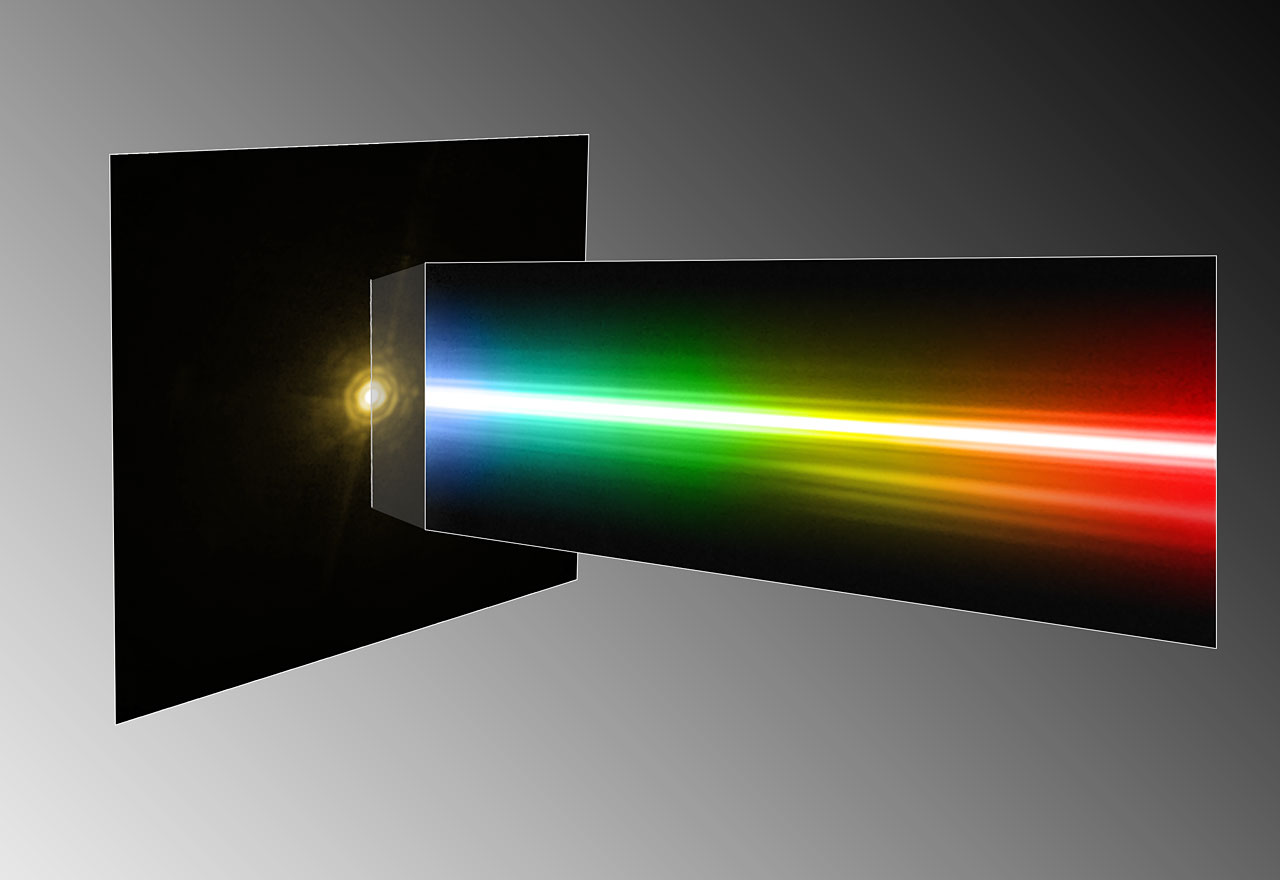Spektroskopia
Mikäli elämän merkkejä milloinkaan löydetään joltakin muulta planeetalta, ne löydetään spektrograafilla
Spektroskopia on yksi tähtitieteilijöiden suosikkityökaluja maailmankaikkeuden ymmärtämiseksi. Planeetat, tähdet ja galaksit ovat yksinkertaisesti liian kaukana analysoitavaksi laboratoriossa. Onneksi hyvin arvokasta tietoa näistä kaukaisista kohteista on kirjoitettu teleskoopeilla havaitsemaamme valoon.
Valo ei kuitenkaan ole kuin avoin kirja. Jotta se voidaan lukea, valo pitää hajottaa osatekijöihinsä eri väreiksi (eli aallonpituuksiksi) samalla tavoin kuin vesipisarat hajottavat valoa muodostaessaan sateenkaaren. Newton kutsui tätä värien sateenkaarta spektriksi, latinankielisen "ilmestystä" tarkoittavan sanan mukaan.
Ensimmäinen tähtitieteellinen spektroskopiakoe oli Fraunhoferin ja Kirshhoffin Auringon valosta tekemä analyysi 1800-luvun alkupuoliskolla. Auringon säteilemän valkoisen valon odotettiin tuottavan puhtaan sateenkaaren sen kulkiessa prisman läpi. Tuolloin huomattiin kuitenkin ensimmäistä kertaa tummien linjojen kuvio. Nämä odottamattomat linjat olivat valon vuorovaikuttaessa eri alkuaineiden kanssa valoon kirjautuneet "sormenjäljet". Niitä kutsutaan absorptioviivoiksi.
Tämän vuorovaikutuksen kauneus on siinä, että jokainen alkuaine tai molekyyli tuottaa yksilöllisen nimikirjoituksen spektriin eli tietyntyyppisen viivakoodin, joka yksiselitteisesti erottaa alkuaineet toisistaan. Selittämällä nämä viivakoodit spektroskopia kykenee paljastamaan minkä tahansa valoa säteilevän tai absorboivan kohteen tärkeät ominaisuudet.
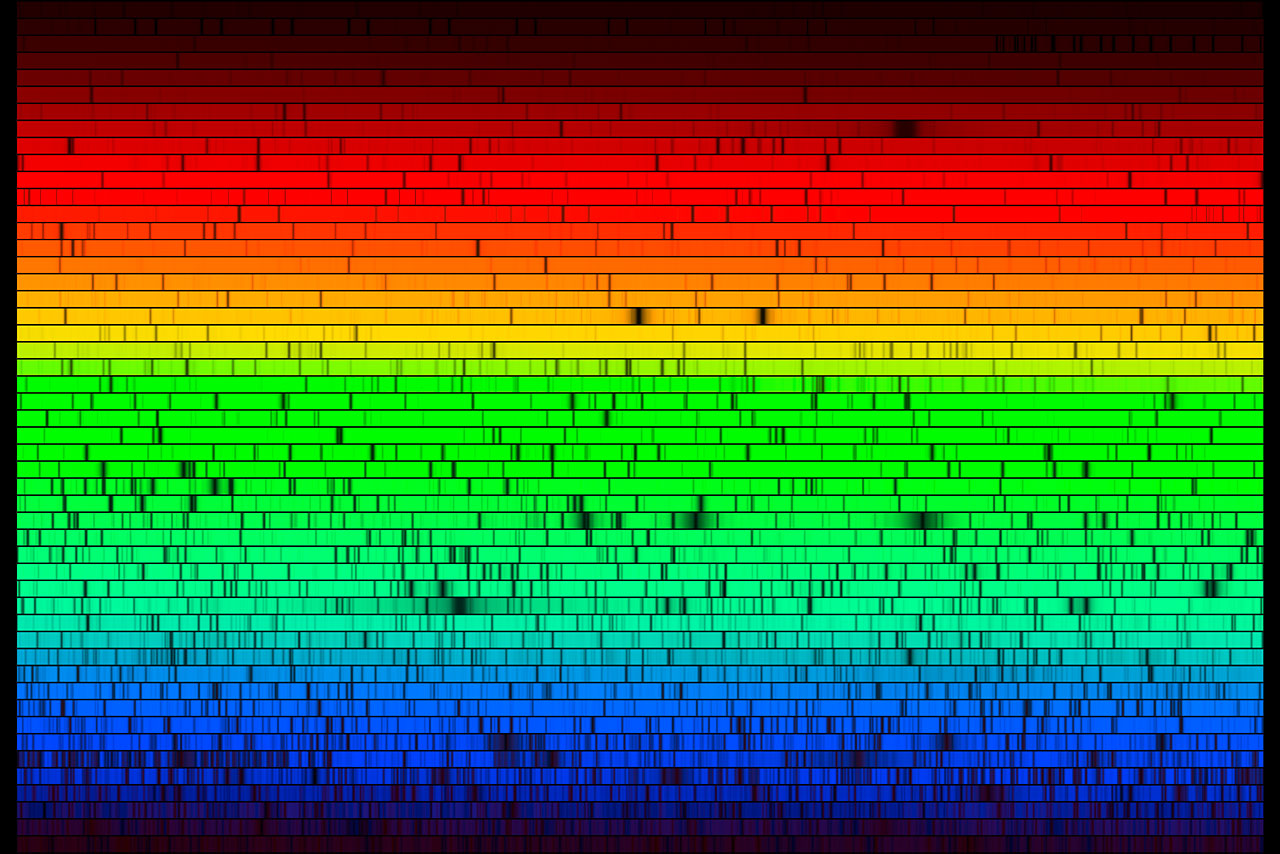
Auringon viivakoodi. Hyvin pitkä spektri on leikattu pienemmiksi paloiksi ja esitetty sitten päällekkäin.
Kuvan oikeudet: NOAO/AURA/NSF
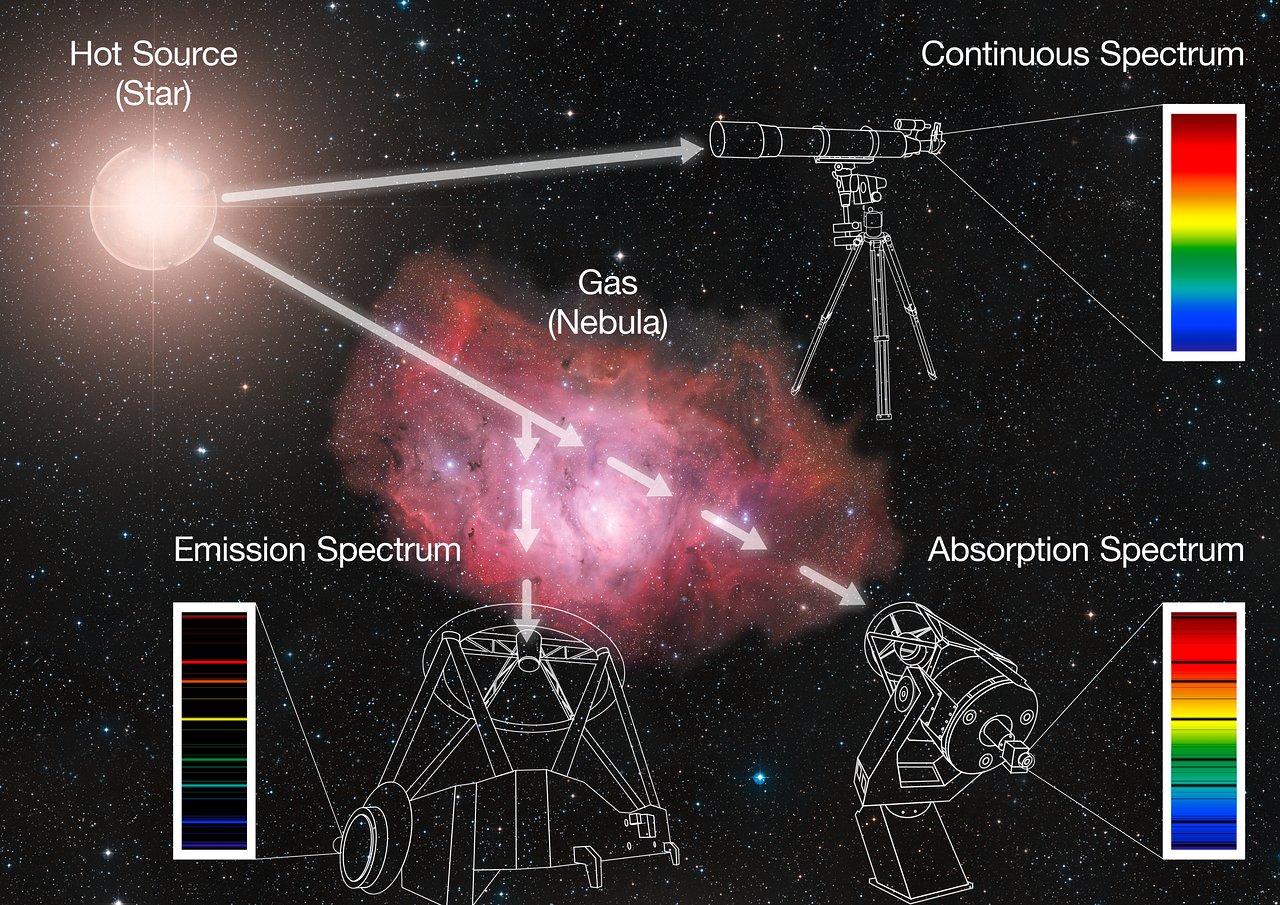
Tähti säteilee valoa kautta koko spektrin — kyseessä on jatkuva spektri eli kontinuumi. Kun valkoinen valo kulkee prisman läpi, se muodostaa sateenkaaren eli spektrin. Samalla tavoin tähden valon kulkiessa kaasun tai kaasusumun halki — tai vaikka vain tähden kaasukehän halki — kaasun sisltämät alkuaineet absorboivat siitä tietyt värit (eli aallonpituudet) aiheuttaen kontinuumiin tummia viivoja. Kyseessä on absorptiospektri. Kaasun absorboima energia säteilee edelleen kaikkiin suuntiin, edelleen kaasun alkuaineille tyypillisillä väreillä, ja tuottaa kirkkaita viivoja tietyillä aallonpituuksilla. Tämä tunnetaan emissiospektrinä.
Spektrograafit ovat olennainen osa tähtitieteellistä havaintolaitteistoa ja ne ovat paljon prismaa monimutkaisempia. Yksinkertaisen sateenkaaren sijaan tuloksena saadaan spektri, jossa valo on paljon sateenkaarta hajaantuneempaa. Spektrit kirjoitetaan CCD-ilmaisimille ja tallennetaan lopulta tietokoneelle tiedostoiksi jatkotutkimuksia ja -analyysia varten. Tähden tai minkä tahansa tähtitieteellisen kohteen spektri ei vain paljasta tiettyjen alkuaineiden läsnäoloa, vaan antaa myös tietoja vallitsevista fysikaalisista olosuhteista kuten lämpötilasta ja tiheydestä. Spektrit voivat kertoa meille myös liikkeestä. Käyttämällä Doppler-ilmiötä, voidaan mitata tähden tai galaksin nopeus suhteessa Maapalloon. Tätä ilmiötä käytetään etsittäessä aurinkokunnan ulkopuolisia planeettoja. Lisäksi vastaavaa ilmiötä käyttämällä tähtitieteilijät voivat mitata galaksien etäisyyksiä. Spektrit sisältävät myös tietoja kohteessa vallitsevasta magneettikentästä, materian koostumuksesta ja monesta muusta asiasta.
Useimmat ESO:n observatorioiden teleskoopit on varustettu spektrograafilla tai niissä on spektroskooppinen havaintotila. Ne kattavat erilaisia aallonpituusalueita (lähiultravioletista keski-infrapunaan) ja tarjoavat erilaisia spektriresoluutioita (mitä suurempi spektrin resoluutio, sitä voimakkaampaa valon hajaantuminen ja pienempiä yksityiskohdat, joita spektristä voidaan havaita).
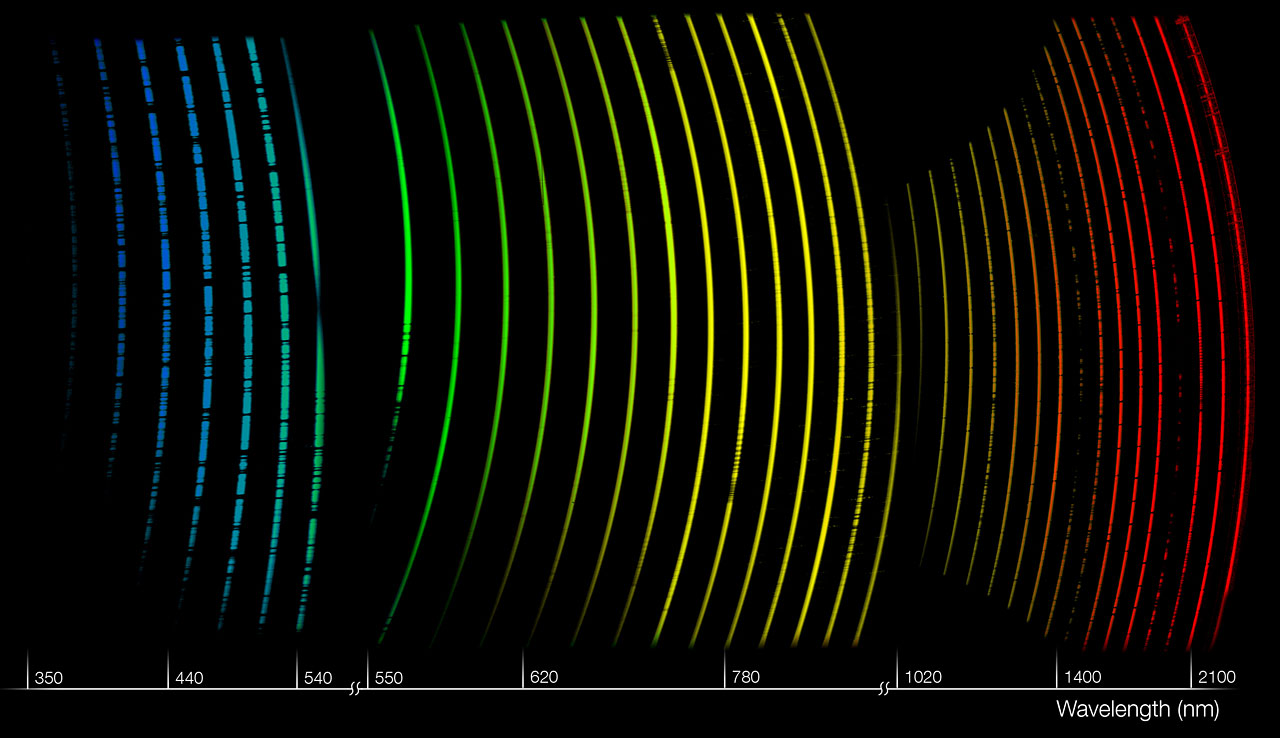
Kuva X-shooter -havaintolaitteella otetusta spektristä. Tämä havaintolaite kykenee ottamaan samanaikaisia spektrejä kohteesta laajalla värien valikoimalla (eli laajalla aallonpituusalueella) ultravioletista infrapunaan.
Jotkin Paranalin VLT-teleskoopit (Very Large Telescope) tuottavat suuren tarkkuuden spektrejä, kuten UVES ja CRIRES. Muut tuottavat spektrejä useista kohteista samanaikaisesti, kuten FLAMES ja VIMOS. Jotkin harvat, kuten KMOS, MUSE ja SINFONI, voivat jopa ottaa spektrin koko näkökentästään (katso Yhtenäiskenttäspektroskopia).
La Sillan observatoriolla spektrograafeja ovat NTT-teleskoopin (New Technology Telescope), EFOSC2 (ja sen edeltäjä EMMI) sekä SOFI. Kieltämättä HARPS, joka on asennettu ESO:n 3.6-metrin teleskooppiin, on yksi kaikkein kuuluisimmista johtuen sen johtavasta asemasta eksoplaneettojen etsinnässä.
ELT-teleskooppiin (Extremely Large Telescope) suunnitellun kaltaiset seuraavan sukupolven spektrograafit menevät selvästi tällä hetkellä mahdollisia havaintoja pitemmälle. Nykyisin mahdottomiin tehtäviin kuuluva mahdollisten elämän merkkien etsiminen Maan kaltaisten eksoplaneettojen kaasukehistä on tähtitieteilijöiden lähitulevaisuuden odotuksissa. Mikäli elämän merkkejä milloinkaan löydetään joltakin muulta planeetalta, löydetään ne luultavimmin spektrograafilla.
Tieteen huippuhetkiä
ESO:n spektrograafit toimittivat avainaineistoa merkittäviin löytöihin tähtitieteen eri osa-alueilla:
- ESO:n 10 tähtitieteellistä huippuhavaintoa
- Aurinkokunnan kappaleita, eksoplaneettoja ja ruskeita kääpiöitä: katso CRIRES:in tieteen huippuhetket;
- Eksoplaneetat: katso HARPS:in tieteen huippuhetket;
- Tähtipopulaatiot: katso FLAMES:in tieteen huippuhetket;
- Kosmologia: katso UVES:in tieteen huippuhetket;
- Linnunradan ytimen supermassiivinen musta aukko: katso SINFONI:n tieteen huippuhetket;
- Galaksien evoluutio: katso VIMOS:in tieteen huippuhetket.
